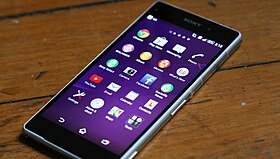 | |
| Brand | Sony |
|---|---|
| Manufacturer | Sony Mobile Communications |
| Type | Touchscreen smartphone |
| Slogan | Details make the difference |
| Series | Sony Xperia |
| First released | March 24, 2014 |
| Availability by region | March 24, 2014 (Taiwan)
March 27, 2014 (China, L50t model exclusively for China Mobile)[1] April 5, 2014 May 1, 2014 May 2, 2014 (China, L50u model exclusively for China Unicom)[2] May 5, 2014 (Canada) May 12, 2014 (India) May 17, 2014 May 19, 2014 (New Zealand) May 21, 2014 (Japan, SO-03F variant exclusively for NTT DoCoMo) July 21, 2014 (United States) |
| Predecessor | Sony Xperia Z1 |
| Successor | Sony Xperia Z3 |
| Related | Sony Xperia Z Sony Xperia Z1 Sony Xperia Z Ultra Sony Xperia Z2 SO-03F (Japan) |
| Compatible networks | D6502: UMTS HSPA+ 850 (Band V), 900 (Band VIII), 1700 (Band IV),1900 (Band II), 2100 (Band I) MHz; GSM GPRS/EDGE 850, 900, 1800, 1900 MHz.
D6503: UMTS HSPA+ 850 (Band V), 900 (Band VIII), 1700 (Band IV),1900 (Band II), 2100 (Band I) MHz; GSM GPRS/EDGE 850, 900, 1800, 1900 MHz; LTE (Bands 1, 2, 3, 4, 5, 7, 8, 13, 17, 20). D6543: UMTS HSPA+ 850 (Band V), 900 (Band VIII), 1700 (Band IV), 1900 (Band II), 2100 (Band I) MHz; GSM GPRS/EDGE 850, 900, 1800, 1900 MHz; LTE (Bands 1, 2, 3, 4, 5, 7, 8). |
| Form factor | Slate |
| Dimensions | 146.8 x 73.3 x 8.2 mm |
| Weight | 163 g |
| Operating system | Android 4.4.2 KitKat (Launch) Android 4.4.4 KitKat Android 5.0.2 Lollipop (last version for SO-03F) Android 5.1.1 Lollipop Android 6.0.1 Marshmallow (current) |
| System-on-chip | Qualcomm Snapdragon 801 |
| CPU | 2.3 GHz quad-core Krait (2.3 GHz Qualcomm MSM8974AB Quad Core) |
| GPU | Adreno 330 |
| Memory | 3 GB RAM |
| Storage | 16 GB (32 GB for SO-03F variant) |
| Removable storage | Up to 128 GB microSDXC |
| Battery | non-user removable Li-ion 3200 mAh |
| Rear camera | Sony G Lens 20.7 MP 1/2.3" Exmor RS IMX220 back-side illuminated sensor with BIONZ™ Engine for mobile image processor and LED flash 2160p video recording @ 30 frames/s 1080p video recording @ 30/60 frames/s 720p video recording @ 30/120 frames/s |
| Front camera | 2.2 MP (1080p video recording) |
| Display | 5.2 in (130 mm) diagonal IPS LCD Full HD 1920x1080 px BRAVIA TRILUMINOS Display with Sony Live Color LED X-Reality Engine for Mobile |
| Connectivity | Wi-Fi DLNA GPS/GLONASS[3] NFC Bluetooth 4.0 MHL 3.0 USB 2.0 (Micro-B port, USB charging) USB OTG 3.50 mm (0.138 in) headphone jack, 5 pole |
| Data inputs | Multi-touch, capacitive touchscreen, proximity sensor |
| Model | D6502, D6503, D6543, L50t, L50u, SO-03F |
| Codename | Sirius |
| Other | Available in black, purple and white IP55 / IP58 (Dust protected, Water jet protected & Waterproof) Digital Noise cancellation Sony Exmor R for Mobile Sony Exmor RS for Mobile Sony G Lens 1/2.3 Aperture sensor Sony BIONZ image processor SteadyShot Smile shutter SensMe TrackID Sony Entertainment Network PlayStation App Remote Play 1seg (SO-03F variant only) Miracast Sony Sketch Magnetic charge port Osaifu-Keitai (SO-03F variant only) NOTTV (SO-03F variant only) POBox Plus (SO-03F variant only) |
| Website | Official website |
The Sony Xperia Z2 is an Android-based smartphone unveiled, manufactured, and marketed by Sony and was released in April 2014. Under the codename "Sirius", Xperia Z2 serves as the successor to the Sony Xperia Z1. Like its predecessor, the Xperia Z2 is water and dust proof with an IP rating of IP55 and IP58. The phone features an IPS LED display, a Snapdragon 801 processor and the ability to record 4K videos. The Xperia Z2 also allows removable microSD storage up to 128 GB.
The Xperia Z2 was unveiled alongside the Sony Xperia Z2 Tablet and the Sony Xperia M2 during the 2014 Mobile World Congress in Barcelona, Spain, on February 24, 2014,[4][5] and was first released in Taiwan on March 24, 2014,[6] in Singapore on April 5, 2014,[7] and entered more markets between April and May 2014. In the United States, the Xperia Z2 was released unlocked through the Sony Store on July 21, 2014.[8]
Many reviewers praised the phone's screen, camera and waterproof design, but criticized its size and camera software issues that cause the device to overheat when recording 4K video for extended periods.[9]
- ^ "Sony Xperia Z2 TD-LTE L50t (Sony Sirius) @ HWBOT". Archived from the original on 2014-11-01. Retrieved 2014-11-01.
- ^ "Sony Xperia Z2 4G TD-LTE L50u (Sony Sirius) @ HWBOT". Archived from the original on 2014-11-01. Retrieved 2014-11-01.
- ^ "Sony's best ever premium smartphone has arrived". Sony. Archived from the original on July 4, 2014. Retrieved July 4, 2014.
- ^ "Sony Xperia Z2 to offer 15.5-megapixel manual mode, 1080p recording at 60fps: Report". NDTV Gadgets. February 10, 2014. Archived from the original on February 11, 2014. Retrieved February 11, 2014.
- ^ "Something extraordinary is coming from Sony..." Sony Xperia. YouTube. February 21, 2014. Retrieved February 22, 2014.
- ^ "Xperia Z2 goes on sale in Taiwan". Xperia Blog. March 24, 2014. Archived from the original on March 30, 2014. Retrieved April 14, 2014.
- ^ "Sony Xperia Z2 now available in Singapore". CNET. April 6, 2014. Archived from the original on April 12, 2014. Retrieved April 14, 2014.
- ^ Reisinger, Don (July 21, 2014). "Sony's Xperia Z2 goes on sale in US, with $50 discount". CNET. Archived from the original on September 25, 2014. Retrieved September 15, 2014.
- ^ Hill, Simon (July 23, 2014). "10 annoying issues with the Sony Xperia Z2, and how to fix them". Digital Trends. Archived from the original on December 29, 2016. Retrieved April 28, 2017.